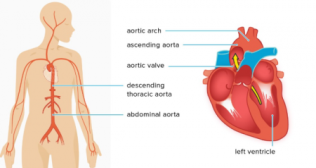
TAVI (Transcatheter Aortic Valve Implantation) in Mumbai
TAVI / TAVR - Transcatheter Aortic Valve Implantation
TAVI / TAVR, which stands for transcatheter aortic valve implantation or transcatheter aortic valve replacement, is a minimally invasive procedure that places an artificial valve inside the defective aortic valve without requiring open heart surgery, where the valve is removed and replaced. Also known as transcatheter aortic valve replacement (TAVR), TAVI is an advanced procedure used to treat a condition called aortic stenosis - a type of heart valve disease in which the aortic valve narrows and doesn’t function as it should, decreasing or blocking the flow of blood from the heart to the body.
TAVI Treatment at Fortis Hospital, Mulund
The TAVI Procedure Program at Fortis Hospital, Mulund, Mumbai, led by Dr. Atul Limaye, a distinguished and US-trained interventional cardiologist, is globally recognized for its expertise in this procedure. Home to highly experienced interventional cardiologists and cardiac surgeons with specialized training and skills in evaluating and treating patients requiring TAVI, the center became the first to perform this procedure in central Mumbai.
At Fortis, our specialists have been performing TAVI with conscious sedation (as opposed to general anesthesia), improving safety of the procedure. As one of the best TAVI hospitals in Mumbai and with a strong multidisciplinary team approach, we are known for high-volume procedures, innovative methods, and better-than-expected outcomes. We are among a few centers in the country, having experienced medical teams, state-of-the-art facilities such as a Cath Lab, and advanced equipment crucial for successful TAVI procedures.
If you or a loved one has been diagnosed with aortic stenosis, a valve replacement using TAVI may be beneficial. Yet, wondering what exactly is TAVI or how does it work? This article provides an overview of TAVI, including the benefits and potential risks associated with the procedure, the success rate, who shouldn’t have it, and more.
What is a TAVI?
TAVI or TAVR is a minimally invasive surgical technique used to treat aortic stenosis. It involves inserting a new valve inside the diseased aortic valve that is narrowed or not working properly. The aortic valve is one of the four valves that regulate blood flow through the heart. The aortic valve opens to enable the flow of blood from the heart to the aorta, which supplies the body with oxygen-rich blood.
Aortic stenosis
In patients with aortic stenosis, the valve narrows or becomes thickened and inflamed, which means the valve cannot open or close properly. This narrowing decreases or blocks blood flow from the heart to the body, causing symptoms such as chest pain, fatigue, shortness of breath, etc. Over time, this condition makes your heart work too hard to pump blood through the narrowed valve to the rest of your body, increasing the risk of heart failure. TAVI is recommended for patients deemed ‘high-risk’ for open heart aortic valve surgery.
How is a TAVI procedure done?
Before the procedure
Your provider or healthcare team will guide you on how to prepare for TAVI. You will be asked to do some tests to ensure that TAVI is a good choice for treating your condition. These may include X-rays, CT scans, ECG, Echo, MRI, and other tests to identify and address any potential problems they may need to fix. Our medical team may also do a cardiac catheterization to assess your arteries for blockages. At Fortis Hospital Mulund, our team of experts will help you understand the benefits and potential risks involved in the procedure.
Talk to your doctor about food and medications such as when to stop eating or drinking, if and when you need to avoid taking certain medications, etc., prior to the procedure.
During the procedure
TAVI is performed by a specialized team that includes an interventional cardiologist, a cardiac surgeon, and a cardiac anesthetist. At the start of the procedure, you will receive sedation to keep you calm or sleepy. You may need to take medicines that help prevent infection and blood clots. With the latest imaging technology, including a state-of-the-art Cath Lab available, specialists at Fortis Hospital Mulund, are performing TAVI with conscious sedation and minimal discomfort, reducing the risk of complications and shortening hospital stay.
- During a TAVI procedure, an interventional cardiologist will make a small incision and insert a new valve made from animal tissue inside the existing, damaged valve using a narrow flexible tube (catheter).
- Usually, the tube is inserted into the groin or thigh and passed it to the aortic valve - although other areas such as the chest or under the collarbone can also be used for this procedure.
- Using advanced imaging technique, the catheter with the new valve is guided to the aortic valve in the heart.
- Once the replacement valve expands, it pushes the diseased valve tissue out of the way and begins to work immediately.
- Before removing the catheter, the doctor will take images and measurements to ensure the new valve has been positioned correctly and works properly.
Throughout the procedure, your medical team will monitor you by constantly checking your vital signs such as blood pressure, oxygen levels, heart rate and rhythm.
After the procedure
You’ll be shifted to the surgical intensive care unit and monitored for at least 24 hours. In most cases, patients can go home the next day after the procedure, although some people may have to stay a little longer in the hospital.
After you’re deemed to be stable for discharge, your care team will give you instructions on how to care for your wounds, prevent infections or blood clot, and when you can return to work, etc. You may be advised to take certain medications to help with your recovery. Make sure that you do not miss regular follow-up appointments with your doctor.
How long does a TAVI procedure last?
A TAVI procedure, which takes place in the Hybrid theatre or Coronary Catheter Lab, usually takes about 1-2 hours from start to finish.
What are the benefits and risks of a TAVI procedure?
The benefits and risks of TAVI may differ from person to person, depending on various factors such as the severity of the condition, age and overall health.
Benefits
TAVI has several benefits over open heart surgery, including:
- Less invasive, which means it requires a much smaller incision compared to open heart valve surgery
- Less pain and faster recovery times
- Shorter hospital stays
- Relieving symptoms of aortic stenosis, thereby improving quality of life and overall health
TAVI is also considered a good option for patients with high surgical risk.
Risks
Fortis Hospital, Mulund, has been performing high volumes of TAVI procedures for years. However, as with any invasive procedure, TAVI is not without risks, although it offers beneficial options to people who otherwise have limited choices for aortic valve repair. Possible risks of TAVI may include:
- Bleeding
- Infection
- Blood clots
- Damage to the aorta
- Blood vessel injury
- Heart rhythm problems, often requiring a pacemaker
- Heart attack
- Heart failure
- Kidney failure
- Stroke
- Leaking of the new valve, resulting in a second TAVI procedure or open heart surgery
- Death in rare cases
You must discuss any concerns with your healthcare team before undergoing the procedure. Also, seek prompt care in case of experiencing any concerning symptoms.
Who should not have a TAVI procedure?
While TAVI offers some advantages over a surgical procedure, everyone cannot have it. This procedure is not recommended for individuals:
- With congenital heart defects or similar problems
- Who have other heart valve problems
- Who have had a heart attack within the past 30 days
- Who require emergency valve surgery
- Having a life expectancy of less than 1 year
- With anatomical issues that make it difficult to perform the procedure
People with aortic valve stenosis seeking treatment at Fortis Hospital, Mulund, are carefully evaluated by a multidisciplinary team of heart valve specialists to determine whether TAVI is the best treatment option.
What is the recovery time and success rate of TAVI?
Normally, most people resume certain activities within days of the procedure, with full recovery in about 6-10 weeks. However, recovery time varies for everyone, depending on their specific case and overall health.
TAVI has a high success rate - with procedural success rates ranging from 90%-95%. Early studies showed that TAVI can be an effective option for high-risk patients compared to surgical procedures. This means, they have a lower risk of complications or deaths from a TAVI procedure. Fortis doctors have years of experience in performing TAVI, delivering excellent outcomes. Our doctors use advanced imaging technology to help them plan and perform TAVI and other transcatheter valve procedures.
Bottom Line
A TAVI procedure can offer several benefits over open heart valve surgery, particularly for people who are at high risk of complications from a traditional surgery. Nonetheless, TAVI is still a major procedure that comes with risks. If you’re living with aortic stenosis, your doctor can help you determine whether you are a good fit for TAVI.
After a TAVI procedure, follow your doctor’s advice carefully to achieve the best possible outcomes. Additionally, make healthier lifestyle choices to help reduce the risk of complications and improve your chances of long-term success. These include – eating more healthily, getting regular exercise, maintaining a healthy weight, etc.
________________________________________________________________________________________________________________________________________
Visit our Best TAVI (Transcatheter Aortic Valve Implantation) Doctors In Mumbai, India
Fortis Hospital Mulund, Mumbai
Address: Mulund Goregaon Link Road, Mulund-West, Mumbai, 400078
Ph. 02268846143
Categories
Clear allMeet the doctor

- Cardiac Sciences | Interventional Cardiology
-
22 Years
-
2500



















